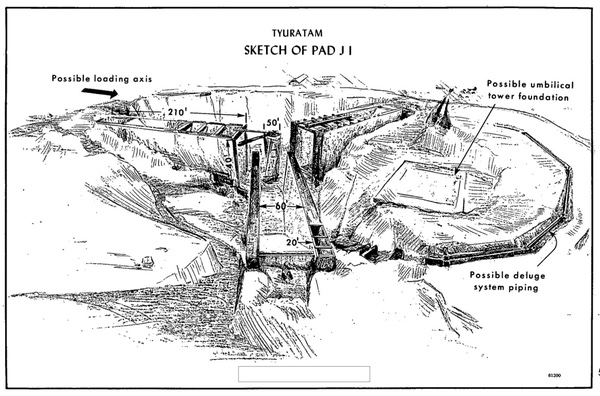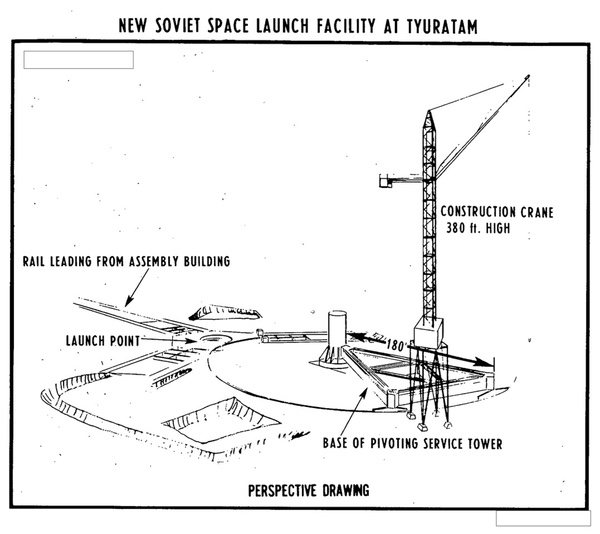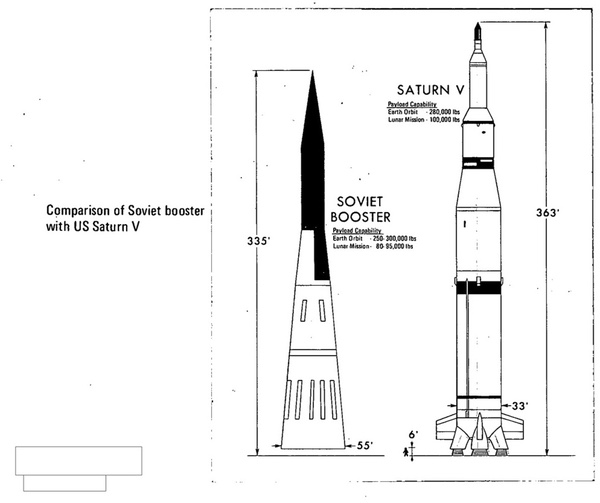
Under a Red Moon: LBJ, the President’s Daily Brief, and the Soviet super rocketby Dwayne Day
|
| Spring 1963 was actually slightly late for starting construction of a facility for launching a large lunar rocket—an indication, although the CIA did not know it, that the Soviets had not immediately responded to Kennedy’s lunar initiative. |
In early 1966, the briefers showed President Lyndon Baines Johnson that the Soviets were building a massive launch complex for a very large rocket. The PDB during Johnson’s time was a relatively short document about eight pages long, usually consisting of one-paragraph summaries of events in different countries. Sometimes it included satellite reconnaissance or other photos. Recently the CIA released thousands of PDBs from the Kennedy and Johnson administrations, and they contain a number of references to the Soviet efforts to challenge Apollo, telling the president where America fared in the race to the Moon.
It is unclear if this February 28, 1966, briefing was the first given to Johnson about Soviet lunar plans. In spring 1963, American spy satellites had detected the first signs of significant construction at the sprawling Soviet launch facility that the Soviets called Baikonur Cosmodrome but the CIA referred to as Tyuratam, located in what was then the Soviet Republic of Kazakhstan. The satellites spotted construction troops’ dormitories being erected, followed by ground excavations of a scale unprecedented at Tyuratam. Subsequent satellite missions returned photographs of the construction of a big building and what intelligence analysts eventually concluded were two launch pads. They labeled the facility “Complex J” since earlier facilities had been labeled Complex A, B, C, and so on.
This construction was not totally unexpected by CIA analysts. After John F. Kennedy had announced the lunar landing goal, and particularly as Apollo began to ramp up, CIA analysts looked for evidence of any kind of Soviet response and even produced estimates of what that response might look like. Spring 1963 was actually slightly late for starting construction of a facility for launching a large lunar rocket—an indication, although the CIA did not know it, that the Soviets had not immediately responded to Kennedy’s lunar initiative. Over the next several years, analysts were perplexed by what they considered to be a rather slow pace for the Soviet program, which did not track with the CIA’s predicted schedule.
What ultimately threw the CIA off were two things that they did not realize until much later. First, infighting within the Soviet government, particularly military opposition to a civilian lunar program, delayed it and starved it of the necessary resources. Second, for various reasons Soviet design engineers took different approaches to rocket development than their American counterparts, particularly eschewing the construction of a big static test stand that could test fire the entire first stage of the large rocket that they were beginning to build. American intelligence analysts kept looking for such a facility in satellite photos and never found one.
By February 1966 CIA officials concluded that Soviet progress was sufficient to include a summary in Johnson’s PDB. The PDB presented to Johnson included a satellite photo showing Complex J and its launch pads, transporter route, and “Missile Assembly Building.” It also included a closeup photo of the two pads, J1 and J2, under construction, and an artist’s drawing of the underground of the pad with three large flame trenches for the rocket.
 |
The summary stated, “This is an immense project. The transporter route between the missile assembly building and the nearest launch pad is over two miles.” It also indicated that one of the pads should be ready by early 1967.
| “Detailed study of the new pictures will provide new insights into this important new system, which is probably associated with a Soviet manned lunar program,” the PDB stated of Complex J. |
In an annex to the PDB the next day the CIA stated that “the first launchings could take place early next year.” It added that “The nature and the size of the construction now indicate that the pads could handle space boosters developing thrusts as great as ten million pounds,” which was more than the Saturn V’s 7.5 million pounds of thrust. “The largest Soviet booster launched to date had a thrust estimated at between 2.5 and three million pounds.”
Intelligence analysts expected to be able to make better estimates of the booster once the launch gantry was built, but they concluded that the closeness of the two pads indicated that the Soviets did not plan on having two boosters in place at the same time. They also estimated that there was high quality housing for 5,000 people near the site and barracks facilities for an equal amount.
The special annex concluded by stating, “It is impossible at this point, of course, to be sure of the objectives of the space program planned for Complex J. The following would be among the feasible possibilities: manned lunar landings, sophisticated planetary probes, and the orbiting of large, manned space stations.”
In August 1966, Johnson received another PDB report on Complex J. This time the CIA informed him that they had received the first imagery from their new, higher-power GAMBIT-3 reconnaissance satellite. It showed that construction was continuing at the dual launch pads. “Detailed study of the new pictures will provide new insights into this important new system, which is probably associated with a Soviet manned lunar program,” the PDB stated.
In March 1967, the President’s Daily Brief again reported on Complex J, this time with a line drawing of the pad facility under construction. A large construction crane was at the site and was beginning assembly of what intelligence analysts concluded was a pivoting service tower. The PDB indicated that the service tower would be “over 300 feet high” and would provide fuel and service for the booster rocket before swinging back for launch.
 |
The next mention of the Soviet launch site in a Daily Brief was in December 1967. The CIA informed Johnson that a reconnaissance satellite had spotted a model of the Soviet space booster: “A vehicle about 320 feet tall and 50 feet in diameter—a bit shorter and fatter than Saturn V—was seen on one of the two giant launch pads under construction at Tyuratam.” The analysts speculated that this was an engineering mockup for checking out the pads and launch facilities, but were unsure if this was an exact model of the actual planned rocket. “The setting up of this check-out vehicle before structural portions of the launch area are completed suggests that the Soviets are wasting no time in readying these facilities,” the Brief concluded.
In June 1968, the PDB again informed Johnson about progress at the Complex J launch site, which satellite photography indicated was nearing completion. “We do not, however, expect an attempt at a manned lunar landing before mid-1971, nor the orbiting of the space station before the mid-1970s.”
| “Assuming the checkout turned up no major difficulties, the first flight test could occur within the next few months,” the PDB stated in January 1969. |
CIA analysts did not simply hand the president his PDB and leave. They usually discussed certain highlights based upon his preferences and answered his questions if they could, taking notes about things he wanted to know more about. We don’t know how Johnson responded to any of these PDB reports on the Soviet space program. The United States had already conducted two Saturn V launches by this time, but was recovering from the setback of the January 1967 Apollo 1 fire. In early 1966, the CIA had predicted that the Soviets would finish their launch site in a year, but two years later it was sill incomplete. Johnson may have asked why the Soviets were not competitive with Apollo. By summer 1968, NASA officials were more concerned about a Soviet manned flight around the Moon than the Soviets beating them to a landing, but we don’t know how much Johnson was aware of this concern.
In August 1968, the PDB included a high-resolution image of the Complex J launch vehicle on its pad and stated that it “may be due for its first flight test.” American satellites continued to get excellent photos of the rocket over the next month (see “The geometry of shadows,” The Space Review, January 12, 2012).
In November 1968, the PDB again revisited the subject and this time included a line drawing of the Soviet booster, which intelligence analysts had concluded was 335 feet tall, next to a 365-foot tall Saturn V. The vehicle was nearing its first flight test and, by that time, had been photographed on its launch pad three times. “A recent satellite mission, however, showed that it has been returned to the nearby assembly and checkout building.” The CIA was hedging their estimates and stated that first launch “still could be several months away.”
 |
The last of the declassified PDBs is dated January 3, 1969, shortly before Johnson left office and after Apollo 8 had successfully orbited the Moon, leaving a landing the only remaining major milestone in the race. The PDB stated that satellite photography had revealed the Soviet booster back on its launch pad after it had previously returned to its checkout building. “Assuming the checkout turned up no major difficulties, the first flight test could occur within the next few months.”
The CIA estimates were as good as their sources and analysts could make them. In fact, the Soviet Union launched its first N-1 rocket from Baikonur Cosmodrome on February 21, 1969. But shockingly, the CIA missed it. The rocket rose off its launch pad and headed downrange and then blew up. It flew high enough and far enough that the scattered debris that fell to the ground was not spotted on later reconnaissance satellite photos. But it had not risen high enough to appear on radar, and other American assets such as listening posts for intercepting telemetry and radio chatter apparently also missed indications of a launch, because the CIA remained unaware of this test flight for many years. It was not until summer 1969, when the second N-1 blew up above its launch pad causing widespread destruction easily apparent in satellite photos, that the CIA concluded that the Soviets had finally tested their giant rocket, and it failed, smashing much of the pad infrastructure that the CIA had been reporting about in Lyndon Johnson’s PDBs.
These newly-released PDBs with their references to the Soviet lunar program represent only a small fraction of the intelligence reports produced about Complex J and its giant rocket. Johnson may have received other specialized briefings on the subject. NASA Administrator James Webb was certainly aware of the project and even received permission to mention it in unclassified congressional testimony (see “Webb’s Giant,” The Space Review, July 19, 2004). The CIA had even built two large models of the facility, one showing the overall launch pad and including both a Saturn V and Washington Monument for scale, and the other showing the launch tower (see “Rockets, real and model-sized,” The Space Review, July 3, 2006). The former is the kind of model that would have been expressly made to show the President of the United States, although it is unknown if Johnson ever saw it.
The Soviets never publicly discussed their large lunar rocket and thus only classified information about it existed until the end of the Cold War. What the newly-released President’s Daily Briefs demonstrate is that this information reached the President of the United States, providing him a running commentary on the progress of the race to the Moon.